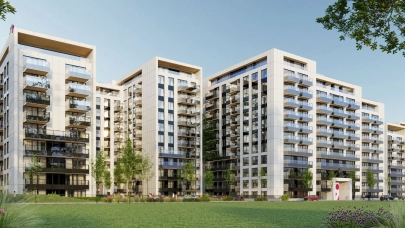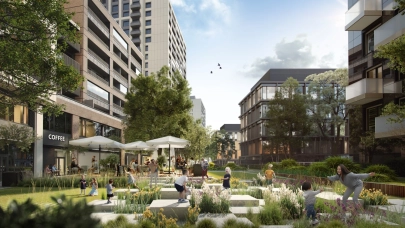
The average flat size in Poland is 21 sqm smaller than the EU average and the overcrowding rate is nearly 20 percentage points higher, says Cushman & Wakefield in its latest report. It is therefore no wonder that despite increasingly prohibitive prices, housing demand continues to grow, thereby fuelling demand for mortgages. According to BIK data, June 2024 saw an almost 52% year-on-year increase in mortgage enquiries, with this growth also driven by interest rate cuts - the first since 2021. It would take Polish people wanting to buy a dream home several years to save up enough for a 20% mortgage deposit. Unfortunately, Cushman & Wakefield’s forecasts indicate that price growth is unlikely to ease to give Polish consumers some respite. Contrary to intentions, factors that are likely to add to their disadvantage include a new governmental support scheme and constrained land availability.
Record performance of the housing market is not enough
According to Cushman & Wakefield, most of Poland’s housing stock of approximately 15.2 million flats is privately owned.
"Developers accounted for around 62% of new housing supply in Poland in the last five years, with 36% contributed by private investors. In 2023, council, social rented housing and company flats made up a mere 2% of all flat completions", comments Karolina Furmańska, Associate, Residential Market Expert, Cushman & Wakefield.
The number of new home starts hit a quarterly high in the first quarter of 2024, which saw developers begin the construction of nearly 42,000 flats, marking an increase of 79% year-on-year and of 33% from the same time in 2022. In addition, the number of flats with building permits issued in the three months to March 2024 increased by 45% year-on-year. This growth translated into more flats for sale in the largest markets. According to data from Otodom, at the end of June, there were more than 50,000 flats on offer on the primary market. Total home completions also remained robust during the first five months of 2024 and were only slightly down compared with the first six months of 2019-2023.
"Despite the record performance of the housing market, Poland continues to experience a severe housing shortage. Its statistical housing deficit is estimated at approximately 1.5 million residential units. This figure is clearly underestimated and does not include various types of housing. On the one hand, it excludes corporate employees, seasonal and foreign workers, war refugees and students, and on the other hand, it is skewed by ‘second homes’, that is residential properties used seasonally and located, for example, in resort towns. No wonder, the towns with the largest number of flats per 1,000 inhabitants are Międzyzdroje and Mielno, with Warsaw ranked 11th", explains Karolina Furmańska.
Rental accommodation, including PRS accommodation, is an alternative to home buying. Although a number of interesting and comprehensive projects came on stream in the largest cities, they are unlikely to close the housing supply gap, according to the report from Cushman & Wakefield. Another 30,000 rental flats are expected to be added to the Polish PRS market in the coming years.
Polish flats fall short of European standards
The severe housing shortage in Poland is aggravated by the overcrowding rate and the average size of flats, which is smaller than in Western Europe.
"The quality and quantity of housing in Poland are among the lowest in the EU. The average flat size in Poland is 75.5 sqm and is 21 sqm smaller than the EU average. In addition, some cities such as Gdańsk, Wrocław and Poznań have in recent years seen the average flat size decrease rather than increase. The average number of rooms per person in Poland is 1.1, or 0.5 less than in the EU, and the overcrowding rate stands at 35.8% and is 19 percentage points above the EU average. This puts Poland among the lower end of European countries for the quality of housing, which - coupled with sky-high prices of flats - constitutes a major barrier to achieving an acceptable standard of living", says Ewa Derlatka-Chilewicz, Head of Research, Cushman & Wakefield.
Approx. 2.3 sqm is what a Warsaw inhabitant earning an average salary can buy after a year of putting aside 50% of income
Average offer prices on the primary market in Poland’s main cities continued to grow at the end of May 2024, with the strongest growth of 21% recorded in Krakow and Łódź. Strong growth was also seen in Poznań (+18%), Wrocław and Gdańsk (+17%). Katowice posted the lowest year-on-year increase in offer prices of 10%. The highest five-year growth of 105% was in Krakow. Significant increases were also recorded in Wrocław and Łódź (87% and 81% respectively), while Gdansk and Warsaw came with 74% and 78% rises respectively.
"The strong upward trend in property prices on the primary market in Poland was largely driven by the 2% Safe Mortgage scheme, which - until it was phased out - pushed offer prices up by 13% in Warsaw, 12% in Krakow and 11% in Gdańsk", says Karolina Furmańska, Cushman & Wakefield.
Prices are also rising on the secondary market. For example, offer prices shot up by 28% year-on-year in Krakow and by 26% year-on-year in Warsaw. Of the largest cities, Gdansk and Katowice recorded the slowest price growth, which was, however, still firmly in double-digit territory at 17%.
Given the average flat prices and average net earnings in each surveyed city in May 2024, the average Warsaw inhabitant putting aside half of their salary would need five years to raise enough funds for a 20% mortgage deposit of the purchase price of a 57 sqm flat. It would take those living in Wrocław, Kraków and Gdańsk more than four years, with Poznań and Łódź inhabitants needing more than three years. Poznań and Katowice have the best price to average net income ratio, with the time required to save for one’s home on both the primary and secondary markets being relatively the shortest. Warsaw is the most expensive city, where it takes 24 years to save up for new builds and 26 years for second-hand homes, with 50% of annual net earnings being put aside. Analysis of data from 20 years ago has revealed improvement. The prime examples are Kraków and Wrocław, where in 2006 it took 36 and 26 years respectively to put aside half of your average salary to buy a flat on the primary market. Polish people’s salaries are also rising, thereby improving their creditworthiness.
The race for mortgages
It is no wonder that most Polish people need to rely on additional funding to realise their dream of owning a flat. The rapid surge in interest rates post-2021 reduced mortgage availability. However, the launch of a new governmental scheme and the first reference rate cuts have led to a revival in consumer interest in bank loans. According to BIK data, June 2024 saw an almost 52% year-on-year increase in mortgage enquiries.
The number of potential mortgagees reached 27,450 at the end of June 2024, up by 25% year-on-year but down by 15.6% from April 2024. The decline was due to an end to the 2% Safe Mortgage scheme at the beginning of the second quarter.
In June 2024, the requested mortgage loan averaged nearly PLN 443,000, up by 15.9% year-on-year and up by 1.7% in May 2024.
More growth on the cards
According to Cushman & Wakefield, flat prices are likely to rise further in late 2024 and in 2025, especially if the new governmental scheme “Apartment for a Start” is implemented.
"Due to still high interest rates and general uncertainty, developers may be unable to increase supply enough for the price growth to slow down. Things are made even worse by the shrinking availability of residential land whose prices continue to trend upwards on the largest markets. According to data from the National Bank of Poland, in 2023, net prices of land for multifamily housing projects rose year-on-year by an average of 20% in secondary locations and 32% in prime locations. Given the new zoning reforms which will take full effect in January 2026, it is only a matter of time before prices go up again", concludes Karolina Furmańska.



